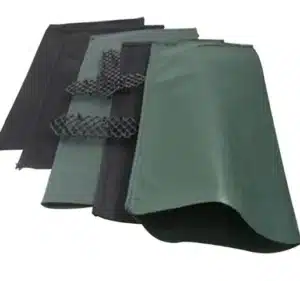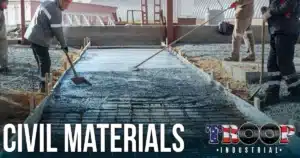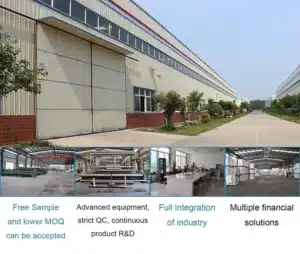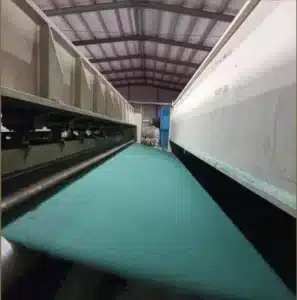Soft ground slows work and burns budget. You might wonder, is there one product that stiffens weak soil fast?
HDPE geocell is a honeycomb confinement system made from high-density polyethylene strips welded into expandable panels. It locks infill, spreads loads, and stabilizes roads, slopes, yards, and foundations with less aggregate.
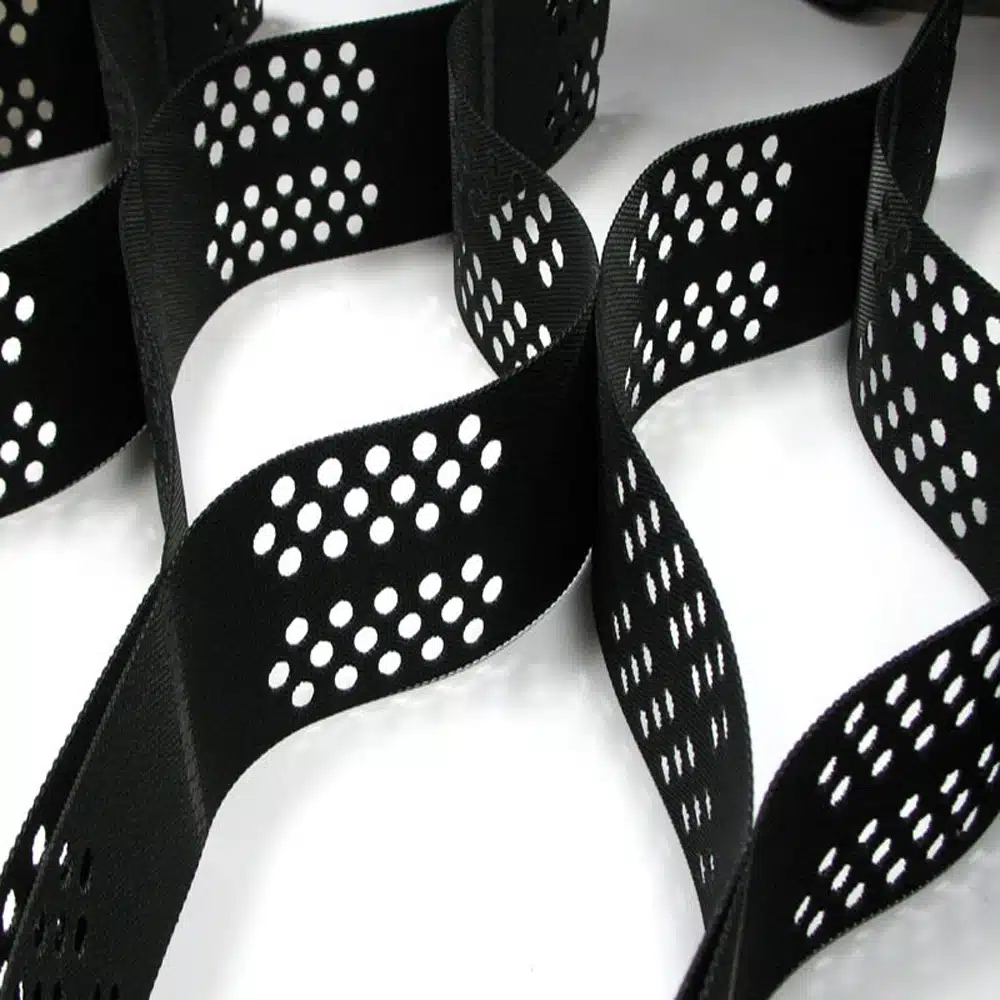
Many buyers mix up geocell with geogrid or simple mats. Let’s clear that up with plain steps. Below you will see what HDPE means, how panels are made, key pros and cons, types, standards, installation, selection rules, and mistakes to avoid.
What is HDPE geocell?
Soft soils pump and rut. Layers shift. Crews add stone and lose time. You want a base that stays stiff and thin.
HDPE geocell is a three-dimensional cellular confinement product. Welded HDPE strips form honeycomb cells that hold soil or stone. The cells stop lateral movement and raise bearing capacity.
What does HDPE mean?
- High-density polyethylene. It is tough, ductile, and chemically resistant.
- It has low water absorption and strong stress-crack resistance.
- It bends without brittle breaks during folding, welding, and field expansion.

How is HDPE geocell made?
Here is the clean, factory flow:
The process starts with resin extrusion into flat strips.We add carbon black for UV resistance, and stabilizers for heat and oxidation resistance. Many strips are embossed to add surface friction. We punch small perforations to improve interlock and drainage where needed. Then we weld the strips at set intervals using ultrasonic welding. The weld pattern defines the cell size and the panel’s nominal dimensions. The panel ships folded like an accordion.
- Raw HDPE material storage
Keep resin dry, clean, and traceable by lot. - Raw material feeding
Meter resin and masterbatch (carbon black and stabilizers). - Sheet extruding and embossing
Extrude flat sheets; add surface texture to raise friction. - Strips cutting
Cut sheets into precise strip widths per design. - Perforating
Punch drainage holes and interlock patterns when specified. - Ultrasonic welding
Weld strips at fixed spacing to define cell size and panel length. - 100% inspection before packing
Check seam peel/shear, strip size, cell height, and visual quality. - Packing
Fold accordion-style, strap bundles, label with full lot data.

What does the system do on site?
- Each cell confines the infill. Confinement turns loose material into a semi-rigid slab.
- Loads spread wider. Shear in the subgrade drops. Rutting stays low.
- On slopes, cells stop downslope movement and hold topsoil or rock.
- In channels, cells resist uplift and reduce surface flow energy.
- The product is light and compact, so you cut truck trips and speed work.
What are the pros and cons of HDPE geocell?
You need honest trade-offs. A tool that helps most of the time, and clear limits when it does not.
Pros include fast build, strong load spreading, less aggregate, and reliable slope stability. Cons include the need for proper anchoring, care in extreme cold, and checks for long-term creep under heavy static loads.
Key pros of HDPE Geocell
- Load distribution: confinement raises the modulus of the infill; sections can be thinner.
- Material savings: local or recycled aggregates often become viable.
- Speed and safety: lightweight panels expand by hand; fewer lifts and less handling.
- Slope and channel control: immediate facing stability with soil, rock, or vegetation.
- Chemical and UV resistance: with 2–3% carbon black and good dispersion.
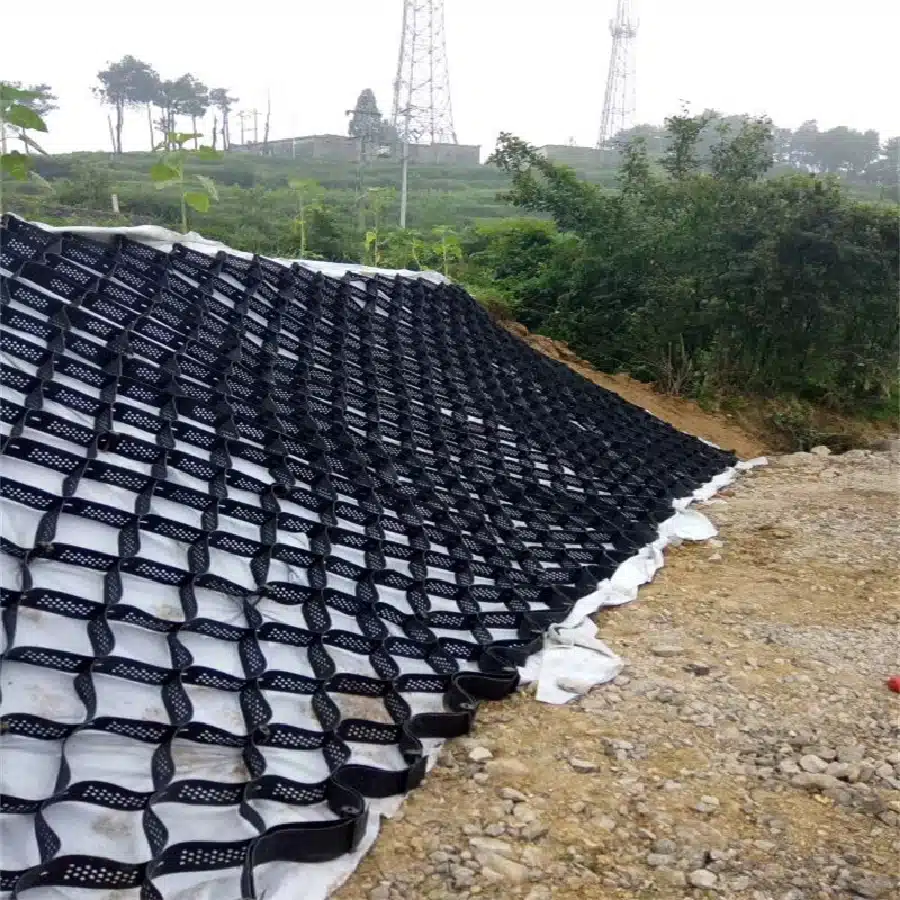
Key cons of HDPE Geocell
- Anchoring must be right, especially on slopes and in channels.
- Handling in very cold weather needs care; avoid sharp bends at low temperature.
- Very high, long static loads require creep checks and cell height tuning.
- Geocell does not replace drainage; water still needs a path out.
- Poor welds or bad storage can cause seam issues; QA matters.
Why is HDPE geocell often better than other geocells?
- Versus PP (polypropylene): HDPE welds more consistently with ultrasonic seams and keeps better ductility at many job-site temperatures. PP can be stiffer but is more sensitive to notch and stress cracking at some temperatures.
- Versus PET (polyester): PET offers high tensile strength but is less common in welded geocell formats and more often used in geogrids. HDPE gives reliable weld bonds, broad chemical resistance, and proven UV durability with carbon black.
- Versus LDPE or blends: HDPE holds shape and seam strength better under compaction, with lower creep than softer blends.
Result: for most road bases, slopes, and access pads, HDPE gives the best mix of weld strength, handling, durability, and price.
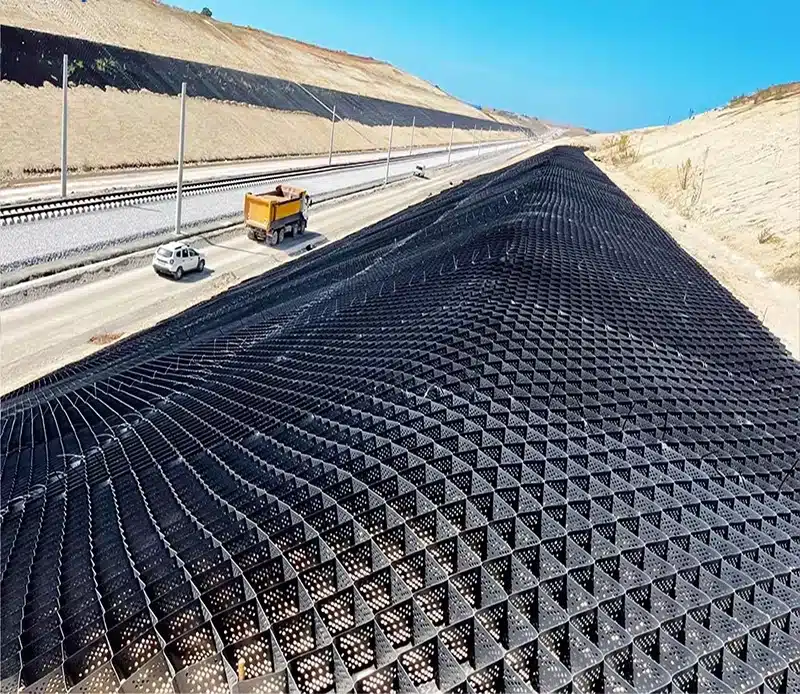
What are the types of HDPE geocell?
Too many options can slow buying. A simple map helps you choose fast and right.
Types vary by strip surface, perforation, cell height, weld spacing (cell size), resin grade, and panel size. Accessories and underlayers complete the system.
By surface
- Smooth: for clean granular infill and fine sands; fast placement.
- Textured: higher interface friction; better for slopes and marginal fills.
By perforation
- Perforated: promotes lateral drainage and interlock; default for bases/slopes.
- Solid: limits cross-flow; useful over liners or in very fine silts.
By cell height (typical)
- 50–75 mm: firm subgrades, footpaths, light duty.
- 100–150 mm: most access roads, yards, and parking.
- 150–200 mm: very soft ground, heavy trucks, steep slopes.
By weld spacing / cell size
- Smaller cells (tighter weld spacing): more confinement; good under point loads and tight turns.
- Larger cells: faster coverage; good for broad areas with uniform loads.
By resin and color
- Virgin HDPE with 2–3% carbon black is standard (black panels).
- Recycled content may be available where specs allow; confirm UV and ESCR.
By panel size and format
- Common heights: 50/75/100/150/200 mm.
- Common expanded cell diagonal: about 250–500 mm.
- Panel lengths and widths vary; select to minimize field seams.
Accessory options
- Underlay: nonwoven geotextile separator on wet fines.
- Connectors: polymer keys, staples, or hog rings.
- Tendons/anchors: for steep slopes or tall faces.
- Facing: topsoil for vegetation, rock armor, or concrete infill for high energy.
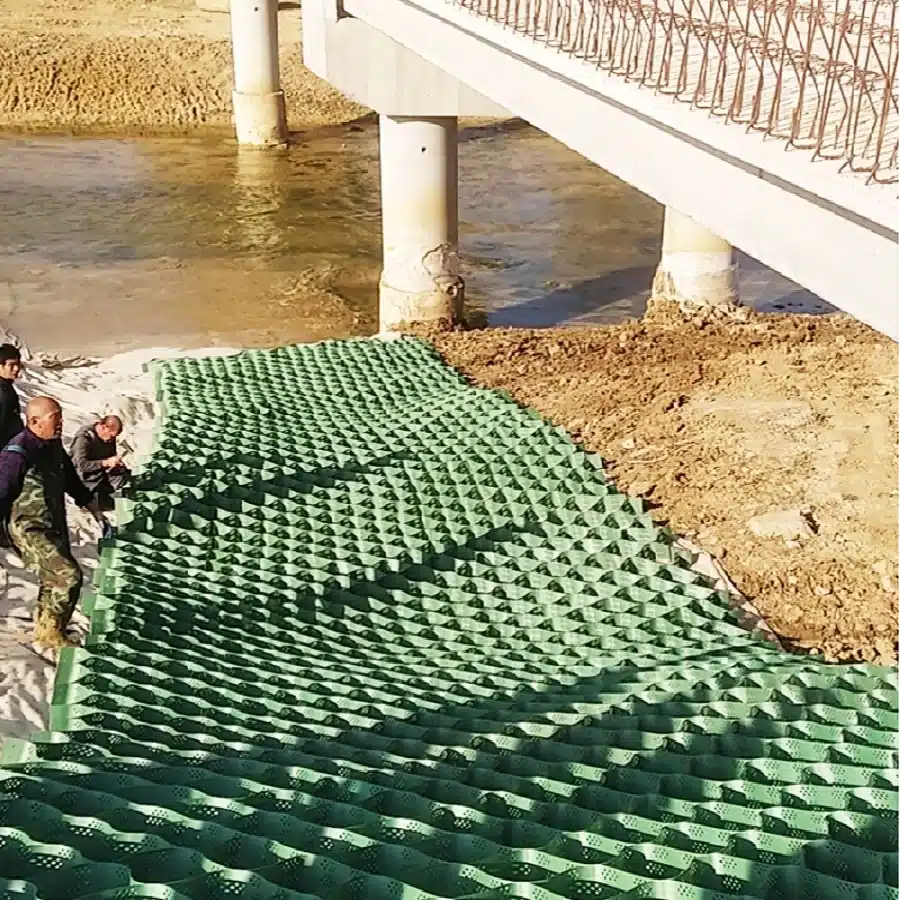
How to install HDPE geocell?
Good material still fails with bad steps. A simple sequence keeps work smooth.
Prepare subgrade, place separator if needed, expand and anchor, connect seams, infill from a fixed edge, compact in thin lifts, and finish with edge restraint.
Dive deeper
1) Subgrade and separator
- Remove sharp debris. Proof-roll to find weak pockets.
- Trim highs, fill lows. Add nonwoven separator on wet/fine soils.
2) Panel layout and expansion
- Place bundles by plan. Expand to design cell size with stretcher bars or stakes.
- Check a few cells with a tape before anchoring.
3) Anchoring and connections
- Flat areas: J-pins or rebar at corners and along edges.
- Slopes: crest anchor trench; backfill; add mid-slope anchors or tendons.
- Connect panels with keys/staples/hog rings per detail; keep joints tight.
4) Infill and compaction
- Start from upslope or a fixed edge to avoid panel drift.
- Limit drop height to protect seams.
- Compact each lift to spec; lift thickness ≤ cell height.
5) Finish and protect
- Top off bases slightly proud; level off.
- For slopes, flush with cell top; add mulch or rock as specified.
- Install edge restraint near pavements; remove temporary stakes; check drainage paths.
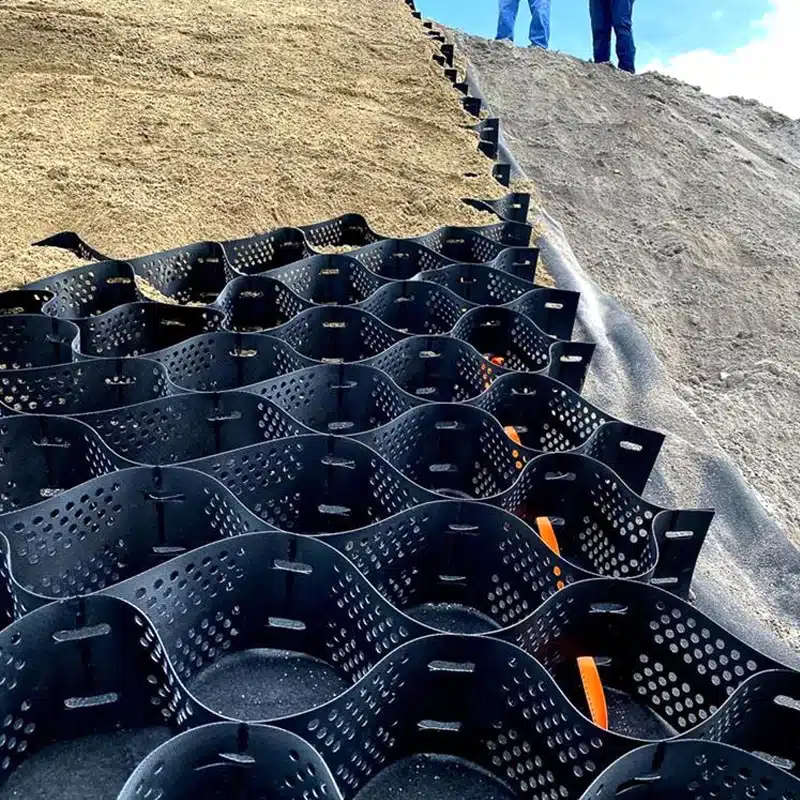
How to choose the right HDPE geocell?
Too many SKUs can freeze decisions. Use a quick rule set and order with confidence.
Match cell height to CBR and traffic, choose textured and perforated for most cases, size the cell to load patterns, and set anchors and underlayers from site risk.
Dive deeper
Fast rules by condition
- CBR < 2: 150–200 mm cells; smaller cell size; nonwoven separator; strong anchoring.
- CBR 2–5: 100–150 mm cells for most access roads and yards.
- CBR > 5: 75–100 mm cells for light to medium traffic.
Traffic and load path
- Heavy trucks, braking, tight turns: taller cells, smaller cells, angular aggregate.
- Occasional access: shorter cells may be enough.
Surface and perforation
- Default: textured and perforated for base and slope work.
- Use smooth/solid above liners or to restrict cross-flow in very fine silts.
Infill choices
- Road bases: well-graded, angular stone or clean recycled concrete.
- Slopes: topsoil for vegetation, or rock for armor; check filters.
Anchoring and details
- Slopes steeper than 1V:1.5H or higher than 3 m: crest trench plus mid-slope anchors.
- Channels: check uplift and drag from design flow; consider solid cells and tendons.
Purchase notes
- Record cell height, surface, perforation, weld spacing, resin requirements, and accessories on the PO line. Clear notes prevent site delays.
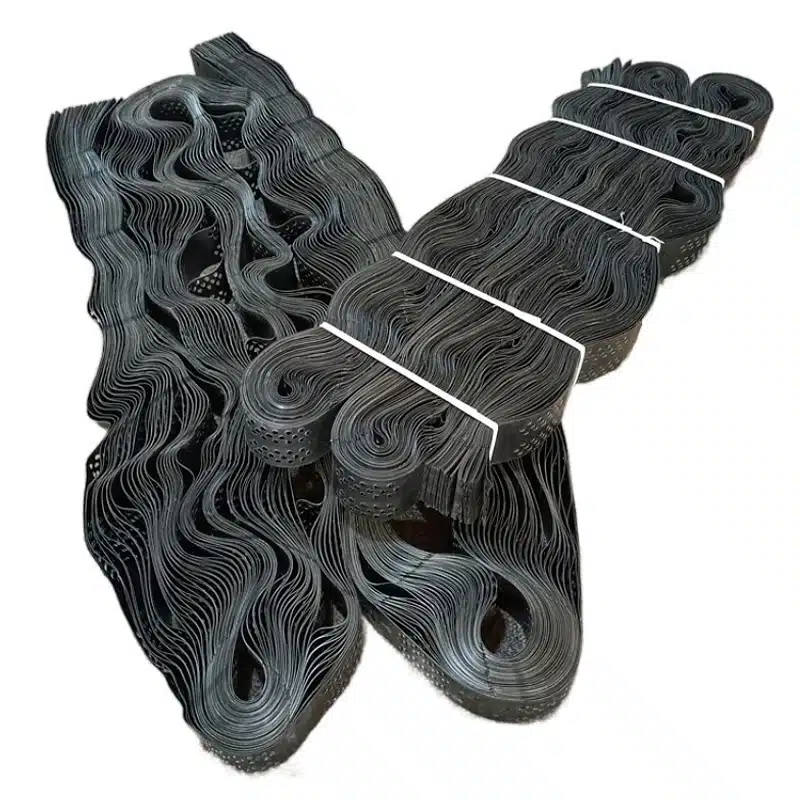
Common mistakes and how to avoid them
Most failures repeat the same five mistakes. Fix them once, save many headaches.
Do not under-anchor, under-compact, over-drop infill, skip separators on wet fines, or leave edges unrestrained.
Dive deeper
Checklist
- Anchors: use the plan spacing; add crest trench on slopes; use correct pin length.
- Compaction: compact each lift before adding the next; keep lifts ≤ cell height.
- Drop height: keep low to protect seams; use chutes or place from the edge.
- Separators: add nonwoven over pumping fines; it is cheap insurance.
- Expansion: measure cell size; use stretcher bars; avoid twisted panels.
- Storage and handling: flat, shaded storage; lift with slings; avoid hooks.
- Cold weather: avoid sharp bends; warm panels if needed; slow down handling.
- Edge restraint: curbs, keys, or beams at pavement interfaces.
- Records: photograph anchors, separators, first lifts, and finished surfaces.
My opinion
I usually suggest to choose by soil risk, not by catalog code. Use HDPE geocell to stiffen weak ground fast, hold slopes, and cut aggregate. Keep specs short and testable. Train crews on day one; after that, the job flows.

FAQ
Is geocell the same as geogrid?
No. Geocell is 3D honeycomb confinement. Geogrid is 2D reinforcement. Uses can overlap, but behavior is different.
Do I need perforated or solid cells?
Perforated is standard for bases and vegetated slopes. Solid is common over liners or in very fine silts.
How tall should the cell be?
100–150 mm fits most bases. Use 150–200 mm for very soft soils or heavy trucks. Use 50–100 mm for firm ground or light duty.
What infill works best?
Angular, well-graded stone for traffic. Soil or rock for slopes. Recycled materials can work when clean and graded.
How long does HDPE last?
With proper carbon black and stabilizers, service life is long when buried. Cover soon to avoid extended UV exposure.
Conclusion
HDPE geocell turns weak ground into a stable, fast-built platform. Pick the right type, follow simple install steps, and you will save stone, gain time, and deliver durable performance.
MJY Geosynthetics Manufacturer has been dedicated to producing high-quality geosynthetic materials for 15 years and is a recognized leader in the industry. If you are interested in finding a reliable one-stop geosynthetics supplier for your project or business, please visit our website for more information:

